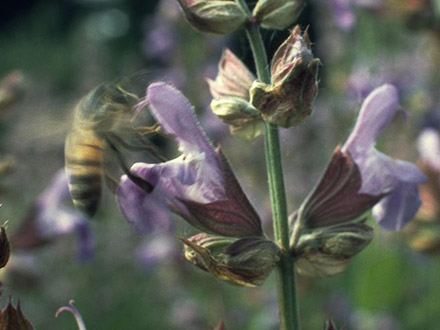Botanical name
Garden or Common Sage, Dalmation sage - Salvia officinalis L.
Family
Labiatae (Lamiaceae)
Information about the plant
Sage is native to the Balkan Peninsula and today it is widespread throughout the Mediterranean up to Portugal and is also farmed in many countries. The genus name Salvia comes from the Latin "salvus" - healthy, safe, saved - and means "the healing". This root word was then used as "sage" in English. The epithet officinalis suggests that it is an ancient medicinal plant because "officina" is the sales room of a pharmacy and "officinalis" means used in the pharmacies. The fragrant sage shrub grows up to 70cm tall and becomes woody very quickly in the lower parts. Its leaves are relatively thick, grey-green, with notable white-tomentose hairs on the abaxial part of the leaves. At the bottom they often have two small ears. When rubbed they smell very much like the characteristic and pleasant essential oil, which is in glandular scales on the leaf´s surface. When these are broken, the essential oil is released. Above the leaf area there many blue lipped flowers, arranged in 5 to 10-flowered whorls as a loose spike. Flowering time is June to July.
Medicinally used parts of plants (herbal drug)
The dried leaves are used with their typical sage scent that is clearly perceived when rubbed. The commercially available drug comes from imports from Southeast European countries.
Constituents of the herbal drug
Sage leaves contain an essential oil with its aromatic smell of thujone, 1.8-cineole, camphor and other monoterpenes. In addition, bitter terpenphenolics and Lamiaceae tannins (mainly rosmarinic acid) and flavonoids.
Quality of the drug
The quality of the following drugs or drug preparations is specified in the European Pharmacopoeia (Ph. Eur.):
- Sage leaf (Salviae officinalis folium)
- Sage tincture (Salviae tinctura)
Medical applications
Recognised medical use
Sage leaves: internally with increased sweating; externally for inflammation of the mouth and throat, gum inflammation (Commission E, ESCOP). Commission E also refers to the internal use in dyspeptic complaints and external use in prosthetic pressure points. The HMPC has classified sage leaves as a traditional herbal medicinal product (see "traditional use").
Traditional use
The HMPC has sage leaves categorised as a traditional herbal medicinal product (§ 39a AMG). Based on many years of experience sage can be used internally for mild dyspeptic complaints such as heartburn and flatulence as well as against excessive sweating; externally for the symptomatic treatment of inflammation in the mouth and throat and to treat mild skin infections. Sage leaves are used internally as a mild-acting drug with increased perspiration and to support the gastrointestinal function; externally to support the functioning of the mucous membranes in the mouth and throat (traditional use acc. to § 109a).
Herbal drug preparations in finished dosage forms
- Sage leaves as a tea
- Alcoholic (tincture) and aqueous extracts in drops, gargle solutions and ointments
- Fluid extract in liquids
- Dried extract in tablets
- Steam distillate in a mixture with other drugs in drops
- Sage oil in liquids (for external use only)
Dosage
Prepared drugs: see package insert;
Tea infusion: sage leaves 4 to 6g daily dose; sage tincture 2.5 to 7.5g daily dose; fluid extract 1.5 to 3g daily dose; sage oil (external) 0.1 to 0.3g daily dose. For gargles and rinses 2.5g of the drug several times daily or add 2-3 tsp the essential oil to 100ml of water as an infusion or 5g of alcoholic extract in 1 glass of water. To brush on, apply alcoholic extracts (tincture) undiluted several times daily.
Preparation of a tea
Mix 3 cups finely chopped sage leaves in boiling water, leave for 10 minutes and then strain. Use warm as a gargle solution, and drink it cold for night sweat. For gastrointestinal complaints mix 2g of the drug with boiling water and strain after 5 min.
Notes
Sage preparations should not be taken during pregnancy and whilst breast-feeding because there are no studies on its safety. The same applies for use in under 18 year olds.
In a public statement about "sage oil", the HMPC came to the conclusion in an assessment of the risk-benefit ratio for the internal use of sage oil, that the risk of using it exceeds the benefits. This is due to the content of toxic thujone, a neurotoxin, that with prolonged use and high doses of oral intake causes epilepticy-like cramps. Thus, the internal use of sage oil is not recommended. The toxic dose of thujone is not in the internal use of preparations from sage leaves (tea infusion, tincture), nonetheless sage preparations should not be taken for longer than 2 weeks. An intake of a maximum of 5.0mg of thujone per day is acceptable. It is recommended to use sage that has chemotypes with the lowest possible level of thujone for internal use.
Side effects
None known
Interactions
Sage preparations may influence the effect of the GABA receptor drugs (e.g. barbiturates, benzodiazepines). Even though this is not clinically proven, the simultaneous intake of such drugs is discouraged.
References
Herbal drug monographs
Further literature
Wichtl: Teedrogen und Phytopharmaka, pg. 591
Schilcher: Leitfaden Phytotherapie, pg. 229
Van Wyk: Handbuch der Arzneipflanzen, g. 283
Kommentar zum Europäischen Arzneibuch (Sage leaves, no. 1370; Sage tincture, no. 1889)


